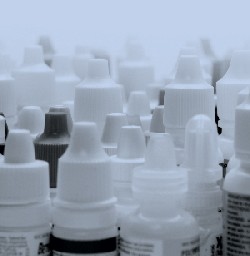 |
 |
Walk into any major pharmacy and you will see that todays selection of dry eye products is as vast and varied as the colors of paint in a hardware store. As such, we must edu- cate patients on the inherent differences between the many brands of artificial tears. And, we must proactively prescribe specific products based on our patients individual needs.
Here, we will discuss the two primary attributes to consider when selecting artificial tears: the type of preservative utilized and viscosity. We will also discuss what drops to prescribe for the various stages of dry eye.
Preservatives
A key consideration when selecting an artificial tear is the type of preservative utilized. Preservatives help to prevent contamination by pathogenic microbes and extend a products shelf life. In artificial tear preparations, preservatives also facilitate the use of larger, multi-dose bottles (e.g., 15 to 30ml).
The most common ophthalmic preservatives are cationic detergents, such as benzalkonium chloride (BAK). These agents disrupt lipids within bacterial cell walls, leading to lysis.1
Unfortunately, many preservatives also have detrimental effects on the tear layer and corneal epithelium. Studies indicate that concentrations of BAK as low as 0.005% can induce pathological changes in living corneal tissue.2,3 In addition, these agents often cause stinging and burning when used chronically. Therefore, preservative-free artificial tears are ideal for individuals who require more frequent instillation.4
The downside of preservative-free products is that they must be packaged in unit-dose containers, generally 0.4 to 0.6ml each, which makes them cost significantly more per application.
Newer preservatives in tears seek to establish a middle ground between convenience and ocular health/comfort. A number of transiently-preserved artificial tears now exist, featuring disappearing preservatives such as Purite, Dissipate and sodium perborate. These agents restrict microbes from growing in the bottle, and quickly break down into inert materials when applied to the eye.
Additionally, several new artificial tears utilize preservatives, such as poly-quaternium-1 (Polyquad) and polyhexamethylene biguanide, traditionally found in contact lens solutions. Products containing these newer preservatives are generally less toxic to ocular structures, and may be suitable for patients who require more frequent administration of artificial tears.
 |
| With so many artificial tears on the market, optometrists must be aware of these products differences and which tears will best meet their patients various needs. |
The beneficial effect of any artificial tear is limited by its residence time; that is, its duration of contact with the ocular surface. Most ophthalmic drops are completely flushed from the eye within five minutes. By increasing viscosity, however, manufacturers can extend the residence time severalfold. The most common viscosity agents are hydroxypropyl methylcellulose (HPMC) and carboxymethylcellulose (CMC). Others include glycerin, polyvinyl alcohol and hydro- xypropyl guar. Obviously, those artificial tears with higher concen-trations of these agents are thicker. Hence, they last longer on the ocular surface.
The disadvantage of increased viscosity, however, is blurred vision. Patients may appreciate the comfort and duration of such products as Refresh Celluvisc (carboxy-methylcellulose sodium 1.0%, Allergan), but these patients will often complain of prolonged blurring. Practitioners and patients must decide which level of viscosity is appropriate.
Prescribing for Dry Eye?
Beyond the warnings above, you should prescribe artificial tears based on the symptomatic and clinical severity of the patients dry eye.
Mild dry eye. Mild dry eye has sporadic symptoms and few signs, save for a reduced tear break-up time (TBUT). These patients usually respond well to low-viscosity, transiently-preserved agents, such as Refresh Tears (Allergan). If the patient elects or needs to use the drops more frequently than q.i.d., then preservatives should be avoided. Refresh Plus (Allergan), Bion Tears (Alcon) or TheraTears (Advanced Vision Research) are excellent choices here.
Moderate dry eye. Moderate dry eye is symptomatic on a daily basis, and shows evidence of ocular surface compromise in the form of fluorescein and/or lissamine green staining and, usually, decreased TBUT. For such patients, increased viscosity often yields the best relief. Some options for these patients include Refresh Liquigel (Allergan) and GenTeal Gel (Novartis). Systane(Alcon) also is an outstanding choice for such cases; it rapidly changes from a liquid drop to a thick gel moments after instillation, and studies have shown that it can extend tear break-up time and diminish ocular surface staining, in addition to alleviating symptoms.5,6 Of course, non-preserved, moderate viscosity agents are an even better choice; options here include Systane Preservative Free (Alcon) and TheraTears Liquid Gel (Advanced Vision Research), among others.
Severe dry eye. Severe dry eye is recognized by notably diminished tear volume, surface tissue changes and profound, life-altering symptoms, such as chronic ocular irritation. Unfortunately, severe dry eye is rarely manageable with artificial tears alone and usually requires intervention with therapeutic agents and/or lacrimal occlusion therapy. For these patients, use only non-preserved, increased-viscosity agents, and consider adding immunomodulatory drugs such as Restasis (cyclosporine ophthalmic emulsion, Allergan).
Lipid-deficient dry eye secondary to meibomian gland dysfunction. This may occur in mod- erate, mild or severe dry eye cases. Blockage of the meibomian gland leads to the diminished secretion of the oil component of the tears. This secretion is necessary to restrict evaporation. The lipid-based emulsions, Refresh Endura (Allergan) and Soothe (Alimera Sciences) are appropriate choices for these patients. Unfortunately, neither are good choices for patients who have aqueous deficiency, as the lipid component tends to create oily tears, resulting in blurry, uncomfortable vision.
While we may not think of artificial tears as being therapeutic products, no one can deny their beneficial effects on alleviating patients symptoms. Treat these agents with the same regard as you would topical medications. Recognize that there are distinct differences between products, and always take the time to select and recommend the best option to each patient.
1. Lemp MA. Dry eye and the use of eyedrops containing preservatives: I. Refract Eyecare Ophthalmol 2004
Jan; 8(1):22.
2. Ichijima H, Petroll WM, Jester JV, et al. Confocal microscopic studies of living rabbit cornea treated with benzalkonium chloride. Cornea 1992 May; 11(3):221-5.
3. Tripathi BJ, Tripathi RC, Kolli SP. Cytotoxicity of ophthalmic preservatives on human corneal epithelium. Lens Eye Toxicity Res1992;9(3-4):361-75.
4. Berdy GJ, Abelson MB, Smith LM, et al. Preservative-free artificial tear preparations. Assessment of corneal epithelial toxic effects. Arch Ophthalmol 1992 Apr;110(4):528-32.
5. Christensen MT, Hearn CJ, Meadows DL, et al. Results of a clinical evaluation with a new artificial tear solution containing HP-Guar. ARVO Abstract #2483, 2003.
6. Pollard S, Stone RP, Christensen MT, et al. Extensions in tear film break-up time after instillation of HP-guar artificial tear substitute. ARVO Abstract #2489, 2003.

